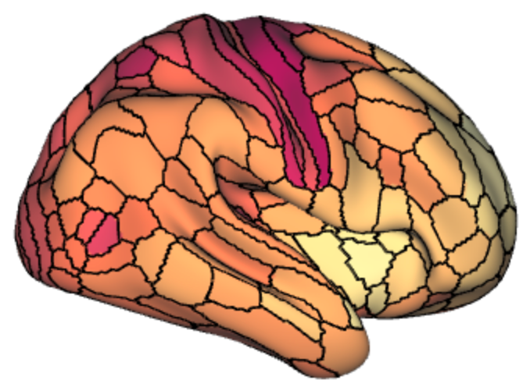By Graham Baum

This image shows the annual rate of change in cortical myelin content measured with T1w/T2w imaging. Lighter colors indicate cortical areas with a slower rate of myelin development, and darker colors indicate cortical areas with a faster rate of myelin development from 8 to 21 years old.
Myelin is a fatty substance that supports healthy brain function by strengthening communication between different brain areas. Myelin also plays in important role in reducing neural plasticity, stabilizing the development of neural circuits that support complex behavior. We used non-invasive MRI indices of cortical myelin content from the Human Connectome Project-Development (HCP-D) to characterize the rate and timing of myelin development from childhood through early adulthood. HCP-D is a large NIH-funded research initiative comprising approximately ∼1750 open access datasets from 1300+ healthy human participants, ages 5-21 years, including cognitive, emotional, and multimodal neuroimaging data acquired at four demographically diverse sites across the USA. Our study used structural neuroimaging data from a subset of the HCP-D, including 628 individuals between the ages of 8 and 21.
We found that cortical areas that process basic sensory information had the most rapid rate of myelin development, while association areas supporting complex cognition had the slowest rate of myelin development from 8 to 21 years old. Together, these findings provide new evidence for prolonged myelin development into the third decade of life, which could reflect ongoing plasticity related to complex cognitive functioning and risk for psychopathology. These data are a prerequisite for studies of neuropsychiatric disorders, which often emerge during adolescence, are increasingly understood as disorders of brain development, and are marked by cognitive dysfunction.
This work was funded in part by the HBI Bipolar Disorder Seed Grant Program, supported by the Dauten Family Foundation and Petri Deryng.
Graham Baum is a postdoctoral fellow in the laboratory of Leah Somerville in the Department of Psychology at Harvard University.
Learn more in the original research article:
Graded Variation in T1w/T2w Ratio during Adolescence: Measurement, Caveats, and Implications for Development of Cortical Myelin. Baum GL, Flournoy JC, Glasser MF, Harms MP, Mair P, Sanders AFP, Barch DM, Buckner RL, Bookheimer S, Dapretto M, Smith S, Thomas KM, Yacoub E, Van Essen DC, Somerville LH. J Neurosci. 2022 Jul 20;42(29):5681-5694.
News Types: Community Stories
